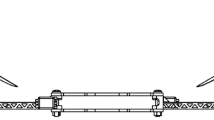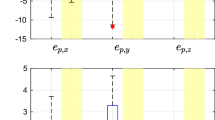Abstract
In this paper, a hierarchical predictive controller is designed in order to solve the tracking problem of a moving ground target by a quad-rotor in an unknown and uneven environment. This controller has internal and external predictive controller levels. In the lower layer of the controller, a constrained predictive controller is designed that is capable of rejecting perturbations and quickly tracking the reference path, and in the outer loop, a model predictive controller is designed to optimally detect the moving ground target where, the sub-cost functions were defined so that the quad-rotor would be able to track the moving ground target even if it was temporarily out of sight of the flying robot, as well as in the event of sudden direction changes and uneven path. In this method, since there is no need to switch between different controllers and not having to engage in delusional maneuvers of the target, the total control effort is reduced, which was shown in the simulations by the indifference reactions and shortening of the path of the quad-rotor. Finally, the tracking problem is simulated in the MATLAB to show the effectiveness of the proposed controllers, and the results are compared with that of a benchmark controller.

















Similar content being viewed by others
References
Gomez-Balderas J-E, Flores G, Carrillo LG, Lozano R (2013) Tracking a ground moving target with a quadrotor using switching control. J Intell Rob Syst 70(1–4):65–78
Eisenbeiß H (2009) UAV photogrammetry. ETH Zurich
Rezaei M (2014) Dynamic modeling, simulation and control of a quadrotor using MEMS sensors’ experimental data. Modares Mech Eng 14(3):176–184
Bouabdallah S, Murrieri P, Siegwart R (2004) Design and control of an indoor micro quadrotor. In: IEEE international conference on robotics and automation. Proceedings. ICRA’04. 2004. IEEE, pp 4393–4398
Tayebi A, McGilvray S (2004) Attitude stabilization of a four-rotor aerial robot. In: 2004 43rd IEEE conference on decision and control (CDC) (IEEE Cat. No. 04CH37601), 2004. IEEE, pp 1216–1221
Nourimotlagh M, Safarpour P, Pourgholi M (2016) Dynamic modeling, simulation and control of a quadrotor using feedback linearization and PID controller based on MEMS sensors’ experimental dat. Modares Mech Eng 16(12):175–185
Chehadeh MS, Boiko I (2019) Design of rules for in-flight non-parametric tuning of PID controllers for unmanned aerial vehicles. J Franklin Inst 356(1):474–491
Mahmoodabadi MJ, Rezaee BN (2020) Fuzzy adaptive robust proportional–integral–derivative control optimized by the multi-objective grasshopper optimization algorithm for a nonlinear quadrotor. J Vib Control 1077:546319901019
Qing L, Wei G, Yuping L, Chunlin S (1997) Aircraft route optimization using genetic algorithms. Science 5:69
Zuo Z (2013) Adaptive trajectory tracking control design with command filtered compensation for a quadrotor. J Vib Control 19(1):94–108
Nadda S, Swarup A (2018) Decoupled control design for robust performance of quadrotor. Int J Dyn Control 6(3):1367–1375
Bertrand S, Guénard N, Hamel T, Piet-Lahanier H, Eck L (2011) A hierarchical controller for miniature VTOL UAVs: design and stability analysis using singular perturbation theory. Control Eng Pract 19(10):1099–1108
Liu H, Bai Y, Lu G, Shi Z, Zhong Y (2014) Robust tracking control of a quadrotor helicopter. J Intell Rob Syst 75(3–4):595–608
Xian B, Diao C, Zhao B, Zhang Y (2015) Nonlinear robust output feedback tracking control of a quadrotor UAV using quaternion representation. Nonlinear Dyn 79(4):2735–2752
Kamel M, Stastny T, Alexis K, Siegwart R (2017) Model predictive control for trajectory tracking of unmanned aerial vehicles using robot operating system. In: Robot operating system (ROS). Springer, pp 3–39
Castillo P, Dzul A, Lozano R (2004) Real-time stabilization and tracking of a four-rotor mini rotorcraft. IEEE Trans Control Syst Technol 12(4):510–516
Tan CK, Wang J, Paw YC, Ng TY (2016) Tracking of a moving ground target by a quadrotor using a backstepping approach based on a full state cascaded dynamics. Appl Soft Comput 47:47–62
Lee S-O, Cho Y-J, Hwang-Bo M, You B-J, Oh S-R (2000) A stable target-tracking control for unicycle mobile robots. In: Proceedings. 2000 IEEE/RSJ international conference on intelligent robots and systems (IROS 2000) (Cat. No. 00CH37113). IEEE, pp 1822–1827
Nelson DR, Barber DB, McLain TW, Beard RW (2007) Vector field path following for miniature air vehicles. IEEE Trans Rob 23(3):519–529
Nadda S, Swarup A (2018) On adaptive sliding mode control for improved quadrotor tracking. J Vib Control 24(14):3219–3230
Gao Q, Cepeda-Gomez R, Olgac N (2014) A test platform for cognitive delays: target tracking problem with multiple time-delayed feedback control. Int J Dyn Control 2(1):77–85
Shi D, Wu Z, Chou W (2019) Anti-disturbance trajectory tracking of quadrotor vehicles via generalized extended state observer. J Vib Control 1077:546319892752
Li Z, Ma X, Li Y (2020) Robust trajectory tracking control for a quadrotor subject to disturbances and model uncertainties. Int J Syst Sci 6:1–13
Alexis K, Nikolakopoulos G, Tzes A (2014) On trajectory tracking model predictive control of an unmanned quadrotor helicopter subject to aerodynamic disturbances. Asian J Control 16(1):209–224
Eskandarpour A, Sharf IJND (2020) A constrained error-based MPC for path following of quadrotor with stability analysis. Science 99(2):899–918
Yang J, Liu C, Coombes M, Yan Y, Chen W-HJIToCST (2020) Optimal path following for small fixed-wing UAVs under wind disturbances
Rascón-Enríquez J, García-Delgado LA, Noriega JR, García-Juárez A, Espinoza ESJE (2020) Tracking Control for Quad-Rotor Using Velocity Field and Obstacle Avoidance Based on Hydrodynamics. Science 9(2):233
Baek SS, Kwon H, Yoder JA, Pack D (2013) Optimal path planning of a target-following fixed-wing UAV using sequential decision processes. In: 2013 IEEE/RSJ international conference on intelligent robots and systems. IEEE, pp 2955–2962
Chen J, Liu T, Shen S (2016) Tracking a moving target in cluttered environments using a quadrotor. In: 2016 IEEE/RSJ international conference on intelligent robots and systems (IROS). IEEE, pp 446–453
Templeton T, Shim DH, Geyer C, Sastry SS (2007) Autonomous vision-based landing and terrain mapping using an MPC-controlled unmanned rotorcraft. In: Proceedings 2007 IEEE international conference on robotics and automation. IEEE, pp 1349–1356
Raffo GV, Ortega MG, Rubio FR (2010) An integral predictive/nonlinear H∞ control structure for a quadrotor helicopter. Automatica 46(1):29–39
Alexis K, Nikolakopoulos G, Tzes A (2011) Switching model predictive attitude control for a quadrotor helicopter subject to atmospheric disturbances. Control Eng Pract 19(10):1195–1207
Das A, Subbarao K, Lewis F (2009) Dynamic inversion with zero-dynamics stabilisation for quadrotor control. IET Control Theory Appl 3(3):303–314
Pollini L, Metrangolo A (2008) Simulation and robust backstepping control of a quadrotor aircraft. In: AIAA modeling and simulation technologies conference and exhibit, p 6363
Zuo Z (2010) Trajectory tracking control design with command-filtered compensation for a quadrotor. IET Control Theory Appl 4(11):2343–2355
Gong X, Bai Y, Hou Z, Zhao C, Tian Y, Sun Q (2012) Backstepping sliding mode tracking control of quad-rotor under input saturation. Int J Intell Comput Cybern 6:19222
Raffo GV, Ortega MG, Rubio FR (2008) Backstepping/nonlinear H∞ control for path tracking of a quadrotor unmanned aerial vehicle. In: 2008 American control conference. IEEE, pp 3356–3361
Camacho EF, Alba CB (2013) Model predictive control. Springer, Berlin
Author information
Authors and Affiliations
Corresponding author
Rights and permissions
About this article
Cite this article
Khankalantary, S., Badri, P. & Mohammadkhani, H. Designing a hierarchical model-predictive controller for tracking an unknown ground moving target using a 6-DOF quad-rotor. Int. J. Dynam. Control 9, 985–999 (2021). https://doi.org/10.1007/s40435-020-00705-z
Received:
Revised:
Accepted:
Published:
Issue Date:
DOI: https://doi.org/10.1007/s40435-020-00705-z




